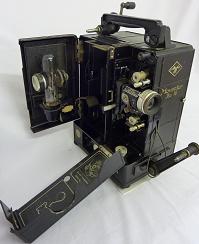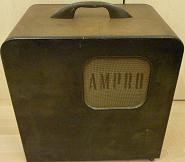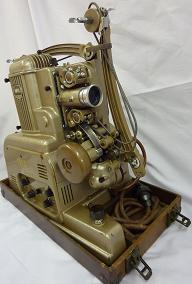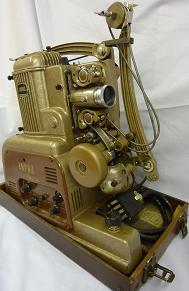|
|
Kodascope Model K-75 - production 1933
Made in USA by Eastman Kodak Co. Rochester, N.Y. The projector is fitted with many unusual mechanisms: oil compartment for lubrication all internal mechanisms; separate mechanism for volt meter adjustment.
The projector has an original carrying case for this model made by Eastman Kodak. Kodascope produced and supplied an oil can for lubrication as well.
Features:
- Lens: made by Eastman Kodak Co., Rochester, N.Y. 2 inch; a special mechanism spring loaded back element at the end of the lens;
- power 100-120 volts, 1100 watts;
- 750 watt lamp;
- takes 400 ft spool;
-Controls knob: forward; still, rewind, thread; revers;
- helical focusing mount;
- central lubrication;
- projection lamp and optical parts attached to hinged door of lamphouse, easy accessible for cleaning;
- the rear wall is fitted with a spring clips ditachabel back panel (the middle pct);
Production number: 6798
|
The oil compartment for the lubrication
Lamphouse |
speed control |
|
|
|
|
|
|
|
Kodascope Model L - production 1935
Made in USA by Eastman Kodak Co. Rochester, N.Y. It was next model after “K”. We can observe a few changes:
- The body of the lamphouse is a little different from model K-75. The finish is in bronze “crystalline” enamel, with chromium-plate exposed metal parts, and there is now cooling fins on its die cast lamphouse casing. This feature lets the owner to select the lamp/lens combination best suiting his needs, so there was a choice of lamps from 300 watts to 750 watts, together with 1 inch to 4 inch lenses.
This kind of lamphouse we can see later in many projector models.
-
Features:
- power 100-125 volts A.C. or D.C.; for voltages 200-250 a Supplementary Resistance must be used; There are three types of Resistance: one for “Kodascope”, fitted with a 300-watt lamp, one for “Kodascope” fitted with 500 0r 750-watt lamp, and one all purpose resistance for 300, 500 or 750 watt lamp; The sliding knob must be set on the Resistance to the figure corresponding to the voltage of a choice of the electric circuit;
- The factory recommended the higher wattage lamps for projecting “Kodacolor” pictures and lower wattage lamps for black and white pictures;
- When the upper reel support is folded it forms a handle for convenient carrying;
- Lens is different in this model. It does not have - a special mechanism spring loaded back element at the end of the lens. The lens is made by Eastman Kodak Co., Rochester, N.Y.; F - 1.6, 2 inch
- speed adjusting knob at the back wall - a little different then in previous model;
- the rear wall does not have an easy access to all internal mechanisms;
- the other features are has not changed, there are the same as in model K-75;
- except the top oil compartment, the other five places are marked in red for lubrication;
- Production number - 2557.
|
speed control & voltage regulator for lamp |
lamphouse
Red marks for lubrication
The rear wall |
|
|
|
|
|
|
|
Agfa - Model Movector Jso - 1938
The projector is next model after Agfa Movector Super 16 mm, made by Agfa- Camerawerk, München 9 Tegernseer Landstrase 161, in 1936.
The body is die cast, with integral texture finished in black enamel with some polished black and bright parts.
The projector had belonged to - Reichsanstalt Für Film und Bild in Wissenschaft und Unterricht (RWU) - Imperial Institute for Film and Image in Science and Education (translated by Google).
It was Reich Office for film education, as “a central point for the production of educational films and tool for co-ordination of the German Education and training system, with headquarters in Berlin” - http://de.wikipedia.org/wiki/Reichsstelle_f%C3%BCr_den_Unterrichtsfilm

The film threading and lubrication instruction are engraved inside the projector door
Features:
- Lens: made by Hugo Meyer & Co Görlitz No 46024; Kinon I; F= 6,5 cm;
f 2,3 (F 65 mm ÷ diameter 28 mm = 2,3); The F= 6,5 cm suggested that the projector was used for projecting films in a large hall.

- Lamp: 375 watts 75 Volts lamp. The lamp swings out on the left hand door and can be adjusted together with the condenser and reflector system - Picture 2
The projector is fitted with an unusual feature. Turning the knob for the adjustment of the lamp brightness, next when the switch off knob is pull down, the knob of adjustment lamp automatically comes back to minus position -Picture 4
- Power: the voltage range is for supplies from 100 to 250, either A.C. or D.C. The projector takes a loads of 6 amps on A.C. and 10 amps on D.C.
- The spools arms are belt driven and the feed arm has a belt slip device to facilitate revolution of the spools during loading. The arms are folding for the transport. The projector takes 400 ft spools.
- Sprockets: film path conventional for two sprocket mechanism.
- Claw mechanism: the claw is a double one working down the left side of the film channel. It is operated by a type of “grass hooper” movement, which gives a very clean entry of the claws, a rocking movement during passage of the film and a very quick and clean exit. The film transit mechanism works forward and in revers. Still pictures can be shown also.
- Shutters: the shutter is two bladed, with an adjustable blade which can be slipped round over the main blade, thus making it into a single bladed shutter. This shutter is geared, however to run at much higher speed than the picture frequency. In this way no flicker can be observe, even at slow projection speeds and with high light intensity - Picture 3.
- Gate: the gate and lens mechanism comes right away for cleaning purpose.
- Silent projector;
- Tilt - the whole projector body can be tilted from the front by turning a knob.
Production number 06739
|
Pict. 3 Shutters |
Pict. 1

Pict.2
Pict. 4 |
|
|
|
|
|
|
|
Ampro - Model Stylist - 1950
The projector is made by Simplex - Ampro Ltd, 167-169 Wardour St.; London in 1950.
The body: the die castings have a copper-brown (named Dimenso) hammer finish. Some parts are plated.
The users had said that it was given “extremely good performance”. The projector makes an impression as it is very heavy, because of the measurement - 16 x 9 ¾ x 18 inches high (40,64 x 24,86 x 45,72 cm). The case is covered with two-tone (brown & dark brown) leatherette.
But it is rather very light: the projector only 23 lb; with the lid 32 lb (14,5kg). This feature was used for the advertisements in 1951; a girl was holding in her hands the projector.
ACW; edition- March 1951 (in our collection)
The upper part of the case houses the 8 inch (20.43 cm) loudspeaker. Unclips from the tray base and disconnected become the speaker. The speaker lead is wound on a 400 ft film reel and held inside the speaker enclosure.
The users had said, in 1951: “This new machine is, without a doubt, one of the quietest 16 mm projectors available.” The price was low - £ 157.10s.
Features:
- Lens: Simplex Ampro Ltd. F=2” f/1.6, the lens is coated.
- Power: Amplifier, motor and lamp work on 115 volts AC or DC. The transformer is supplied for use on 200 - 250 volt mains. The transformer has a compartment to take the cable.
The transformer
- Lamp: the lamp is a standard 110 volt 750 watt pre-focuse type.
A 1,000 watt lamp can be used. The lamphouse has very good cooling. The concave reflector behind the lamp, and double condenser in front of the lamp, are fitted on the side of the lamphouse. It is removable, as it is visible in the picture below - at the base of the projector:
- Mechanism: The mechanism is driven by a small flat rubber belt up from the motor to the vertical camshaft:
- Claw: the mechanism of the projector has triple claw.
- Sprockets & Gate: the gate opens forwards. The gate aperture itself is in the rear half of the gate, and the lens carrier opens about ⅜ inch ( 9,5 mm). Gate and sprockets do not touch the picture or sound track areas of the film; side pressure springs at the gate prevent side float.
- Shutters: is located just behind the gate. It is the barrel type and gives three obscurations per frame (picture above).
- Tilt: the projector can be tilted by a single screw on the front
- Sound & Amplifier: The amplifier is small. It contains:
- one 8D5 pre-amplifier;
- one 12A7 voltage amplifier and phase splitter;
- two 50C5 output valves in push-pull, are used, giving 3½ watts output. It to be ample for a large room or small hall, as tests showed.
The tests showed as well, that sound quality is exceptionally good, “pleasing reproduction of an orchestral film”
A jack socket on the amplifier allows a gramophone pick-up or microphone to be used.
Optical sound;
- Spools: the spool arms takes up to 2,000 ft (600 meters about) capacity, fold up for storage The film can be rewound on the projector without changing the belt. Fast automatic rewind.
Production number S 5178 |
|

The lid with the speaker & cable

|
|
|
|
|
|
|
|
Ampro - Model Stylist - 1950
A Main features are similar to the projector described above. Only deferent is a colour of the side wall - a little darker.
Next different feature is the lamp, changed by the last owner. It is a halogen lamp: 24 volts, 250 watts. The owner fitted the small metal cover on the top of the projector, to prevent of emission too much stray light from the top of lamphouse.
Production number S 5653
The description was written based on some information from ACW - December 1950 - in our collection. |
|

|
|
|
|
|
|
|
|
page (1) (2)
|
|
|
|
|
Page Back
|
|
|
|